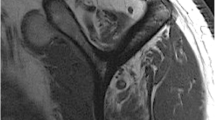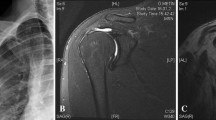Abstract
Purpose
Latissimus dorsi tendon (LDT) transfer (LDTT) to the greater tuberosity to treat irreparable posterosuperior rotator cuff tears (RCTs) in young active patients has been shown to have up to 36% of clinical failures, most of them happening because of either deltoid origin disruption or post-operative transfer rupture from the greater tuberosity. In an attempt to simultaneously prevent both complications, a modified technique includes the following adaptations to the original technique: reinforcement and augmentation of the LDT with a tendinous allograft, enabling the use of a single deltopectoral approach. The aim of this study is to compare mid-term outcomes of the traditional LDTT technique with this modified transfer.
Methods
Retrospective cohort study comparing two groups who underwent either the traditional (group 1; n = 19) or the modified technique (group 2; n = 27). Group homogenization was assured by statistical comparison of 24 baseline independent variables. The outcome variables were the gains to active shoulder range of motions (ROM) and UCLA scores (and all its subscores, independently), at a minimum follow-up of two years. A p value < .05 was considered to be statistically significant.
Results
At a mean follow-up of 25 months, both groups have shown improvements to most variables. However, group two (modified technique) achieved greater improvements to UCLA score (p = .009), active external rotation (p = .006) and internal rotation (p = .008).
Conclusion
At mid-term follow-up, improvements to outcomes of the modified (single approach, allograft-enhanced) latissimus dorsi transfer were greater than those of the original technique.




Similar content being viewed by others
Data availability
The authors affirm that all material, data and software application used in the making of this study support our published claims and comply with field standards. The data in this study is original and has not been re-used from other published or unpublished material.
References
Collin PG, Gain S, Nguyen Huu F, Lädermann A (2015) Is rehabilitation effective in massive rotator cuff tears? Orthop Traumatol Surg Res 101:S203–S205. https://doi.org/10.1016/j.otsr.2015.03.001
Mulieri P, Dunning P, Klein S et al (2010) Reverse shoulder arthroplasty for the treatment of irreparable rotator cuff tear without glenohumeral arthritis. J Bone Joint Surg Am 92:2544–2556. https://doi.org/10.2106/JBJS.I.00912
Ernstbrunner L, Suter A, Catanzaro S et al (2017) Reverse total shoulder arthroplasty for massive, irreparable rotator cuff tears before the age of 60 years: long-term results. J Bone Joint Surg Am 99:1721–1729. https://doi.org/10.2106/JBJS.17.00095
Westermann RW, Pugely AJ, Martin CT et al (2015) Reverse shoulder arthroplasty in the united states: a comparison of national volume, patient demographics, complications, and surgical indications. Iowa Orthop J 35:1–7
Checchia C, Domos P, Grimberg J, Kany J (2019) Current options in tendon transfers for irreparable rotator cuff tears. JBJS Rev 7:e6. https://doi.org/10.2106/JBJS.RVW.18.00044
Burkhart SS, Hartzler RU (2019) Superior capsular reconstruction reverses profound pseudoparalysis in patients with irreparable rotator cuff tears and minimal or no glenohumeral arthritis. Arthrosc J Arthrosc Relat Surg Off Publ Arthrosc Assoc N Am Int Arthrosc Assoc 35:22–28. https://doi.org/10.1016/j.arthro.2018.07.023
Mihata T, Lee TQ, Watanabe C et al (2013) Clinical results of arthroscopic superior capsule reconstruction for irreparable rotator cuff tears. Arthrosc J Arthrosc Relat Surg Off Publ Arthrosc Assoc N Am Int Arthrosc Assoc 29:459–470. https://doi.org/10.1016/j.arthro.2012.10.022
Aibinder WR, Elhassan BT (2018) Lower trapezius transfer with Achilles tendon augmentation: indication and clinical results. Obere Extrem 13:269–272. https://doi.org/10.1007/s11678-018-0489-6
Elhassan BT, Sanchez-Sotelo J, Wagner ER (2020) Outcome of arthroscopically assisted lower trapezius transfer to reconstruct massive irreparable posterior-superior rotator cuff tears. J Shoulder Elbow Surg 29:2135–2142. https://doi.org/10.1016/j.jse.2020.02.018
Elhassan BT, Wagner ER, Werthel J-D (2016) Outcome of lower trapezius transfer to reconstruct massive irreparable posterior-superior rotator cuff tear. J Shoulder Elbow Surg 25:1346–1353. https://doi.org/10.1016/j.jse.2015.12.006
Stone MA, Kane LT, Ho JC, Namdari S (2021) Short-term outcomes of lower trapezius tendon transfer with achilles allograft for irreparable posterosuperior rotator cuff tears. Arthrosc Sports Med Rehabil 3:e23–e29. https://doi.org/10.1016/j.asmr.2020.08.004
Valenti P, Werthel J-D (2018) Lower trapezius transfer with semitendinosus tendon augmentation: Indication, technique, results. Obere Extrem 13:261–268. https://doi.org/10.1007/s11678-018-0495-8
Gerber C, Vinh TS, Hertel R, Hess CW (1988) Latissimus dorsi transfer for the treatment of massive tears of the rotator cuff: A preliminary report. Clin Orthop Relat Res 232:51–61
El-Azab HM, Rott O, Irlenbusch U (2015) Long-term follow-up after latissimus dorsi transfer for irreparable posterosuperior rotator cuff tears. J Bone Joint Surg Am 97:462–469. https://doi.org/10.2106/JBJS.M.00235
Gerber C, Rahm SA, Catanzaro S et al (2013) Latissimus dorsi tendon transfer for treatment of irreparable posterosuperior rotator cuff tears: long-term results at a minimum follow-up of ten years. J Bone Joint Surg Am 95:1920–1926. https://doi.org/10.2106/JBJS.M.00122
Irlenbusch U, Bracht M, Gansen H-K et al (2008) Latissimus dorsi transfer for irreparable rotator cuff tears: a longitudinal study. J Shoulder Elbow Surg 17:527–534. https://doi.org/10.1016/j.jse.2007.11.022
Kany J, Grimberg J, Amaravathi RS et al (2018) Arthroscopically-assisted latissimus dorsi transfer for irreparable rotator cuff insufficiency: modes of failure and clinical correlation. Arthrosc J Arthrosc Relat Surg Off Publ Arthrosc Assoc N Am Int Arthrosc Assoc 34:1139–1150. https://doi.org/10.1016/j.arthro.2017.10.052
Sher JS, Iannotti JP, Warner JJ et al (1997) Surgical treatment of postoperative deltoid origin disruption. Clin Orthop 343:93–98
Kany J, Sekaran P, Grimberg J et al (2020) Risk of latissimus dorsi tendon rupture after arthroscopic transfer for posterior superior rotator cuff tear: a comparative analysis of 3 humeral head fixation techniques. J Shoulder Elbow Surg 29:282–290. https://doi.org/10.1016/j.jse.2019.06.019
Moursy M, Forstner R, Koller H et al (2009) Latissimus dorsi tendon transfer for irreparable rotator cuff tears: a modified technique to improve tendon transfer integrity. J Bone Joint Surg Am 91:1924–1931. https://doi.org/10.2106/JBJS.H.00515
Habermeyer P, Magosch P, Rudolph T et al (2006) Transfer of the tendon of latissimus dorsi for the treatment of massive tears of the rotator cuff: a new single-incision technique. J Bone Joint Surg Br 88:208–212. https://doi.org/10.1302/0301-620X.88B2.16830
Grimberg J, Kany J, Valenti P et al (2015) Arthroscopic-assisted latissimus dorsi tendon transfer for irreparable posterosuperior cuff tears. Arthrosc J Arthrosc Relat Surg Off Publ Arthrosc Assoc N Am Int Arthrosc Assoc 31:599-607.e1. https://doi.org/10.1016/j.arthro.2014.10.005
Miyazaki AN, Checchia CS, de Lopes WC et al (2019) Latissimus dorsi tendon transfer using tendinous allograft for irreparable rotator cuff lesions: surgical technique. Rev Bras Ortop 54:99–103. https://doi.org/10.1055/s-0038-1676989
Miyazaki AN, Checchia CS, Fonseca Filho JM et al (2022) Results of latissimus dorsi transfer using a tendinous allograft through a single deltopectoral approach for irreparable posterosuperior rotator cuff tears. Rev Bras Ortop 57:590–598. https://doi.org/10.1055/s-0041-1724073
Tokish JM, Alexander TC, Kissenberth MJ, Hawkins RJ (2017) Pseudoparalysis: a systematic review of term definitions, treatment approaches, and outcomes of management techniques. J Shoulder Elbow Surg 26:e177–e187. https://doi.org/10.1016/j.jse.2017.02.024
Fuchs B, Weishaupt D, Zanetti M et al (1999) Fatty degeneration of the muscles of the rotator cuff: assessment by computed tomography versus magnetic resonance imaging. J Shoulder Elbow Surg 8:599–605. https://doi.org/10.1016/S1058-2746(99)90097-6
Lafosse L, Lanz U, Saintmard B, Campens C (2010) Arthroscopic repair of subscapularis tear: surgical technique and results. Orthop Traumatol Surg Res 96:S99–S108. https://doi.org/10.1016/j.otsr.2010.09.009
Hamada K, Fukuda H, Mikasa M, Kobayashi Y (1990) Roentgenographic findings in massive rotator cuff tears. A long-term observation. Clin Orthop 254:92–96
Codsi M, McCarron J, Brems JJ (2009) Clinical evaluation of shoulder problems. In: Rockwood CA Jr, Matsen FA III, Wirth MA (eds) The shoulder, 4th edn. Saunders Elsevier, Philadelphia
Ellman H, Hanker G, Bayer M (1986) Repair of the rotator cuff. End-result study of factors influencing reconstruction. J Bone Joint Surg Am 68:1136–1144
Thomazeau H, Rolland Y, Lucas C et al (1996) Atrophy of the supraspinatus belly. Assessment by MRI in 55 patients with rotator cuff pathology. Acta Orthop Scand 67:264–268
Melis B, DeFranco MJ, Lädermann A et al (2011) The teres minor muscle in rotator cuff tendon tears. Skeletal Radiol 40:1335–1344. https://doi.org/10.1007/s00256-011-1178-3
Zdravkovic V, Jost B (2018) Rounded data have a high potential for false comparative statistical results as shown with elbow arc of motion. J Shoulder Elbow Surg 27:276–281. https://doi.org/10.1016/j.jse.2017.10.033
Gerber C, Maquieira G, Espinosa N (2006) Latissimus dorsi transfer for the treatment of irreparable rotator cuff tears. J Bone Joint Surg Am 88:113–120. https://doi.org/10.2106/JBJS.E.00282
Petri M, Greenspoon JA, Bhatia S, Millett PJ (2015) Patch-augmented latissimus dorsi transfer and open reduction-internal fixation of unstable os acromiale for irreparable massive posterosuperior rotator cuff tear. Arthrosc Tech 4:e487–e492. https://doi.org/10.1016/j.eats.2015.05.007
Pogorzelski J, Horan MP, Godin JA et al (2018) Achilles tendon allograft-augmented latissimus dorsi tendon transfer for the treatment of massive irreparable posterosuperior rotator cuff tears. Arch Orthop Trauma Surg 138:1207–1212. https://doi.org/10.1007/s00402-018-2943-8
Hendawi T, Godshaw B, Flowers C et al (2019) Autograft vs allograft comparison in pediatric medial patellofemoral ligament reconstruction. Ochsner J 19:96–101. https://doi.org/10.31486/toj.18.0081
Getgood A (2016) Hamstring autograft had better long-term survivorship than tibialis posterior tendon allograft for anterior cruciate ligament reconstruction. J Bone Jt Surg 98:872. https://doi.org/10.2106/JBJS.16.00209
Checchia CS, da Silva LA, do Val Sella G et al (2021) Opções atuais de transferências tendíneas para lesões posterossuperiores irreparáveis do manguito rotador. Rev Bras Ortop 56:281–290. https://doi.org/10.1055/s-0040-1709988
Acknowledgements
None.
Funding
The authors declare that no funds, grants, or other support were received during the preparation of this manuscript.
Author information
Authors and Affiliations
Contributions
All authors contributed to the study conception and design. Material preparation, data collection and analysis were performed by Caio Santos Checchia. The first draft of the manuscript was written by Caio Santos Checchia and all authors commented on previous versions of the manuscript. All authors read and approved the final manuscript.
Corresponding author
Ethics declarations
Ethics approval
This study was performed in line with the principles of the Declaration of Helsinki. Approval was granted by the Ethics Committee of “Comitê de Ética em Pesquisa da Irmandade da Santa Casa de Misericórdia de São Paulo" under the approval number “CAAE 08077319.0.0000.5479”.
Consent to participate
Informed consent was obtained from all individual participants included in the study.
Consent to publish
The authors affirm that human research participants provided informed consent for publication of the images in Figs. 1b, 2b, 3 and 4b.
Conflict of interest
On behalf of all authors, the corresponding author states that there is no conflict of interest.
Competing interests
The authors have no relevant financial or non-financial interests to disclose.
Additional information
Publisher's note
Springer Nature remains neutral with regard to jurisdictional claims in published maps and institutional affiliations.
Rights and permissions
Springer Nature or its licensor (e.g. a society or other partner) holds exclusive rights to this article under a publishing agreement with the author(s) or other rightsholder(s); author self-archiving of the accepted manuscript version of this article is solely governed by the terms of such publishing agreement and applicable law.
About this article
Cite this article
Checchia, C.S., da Silva, L.A., do Val Sella, G. et al. Allograft-enhanced latissimus dorsi transfer is better than the conventional technique for irreparable posterosuperior rotator cuff tears. A retrospective matched cohort. International Orthopaedics (SICOT) 47, 1527–1534 (2023). https://doi.org/10.1007/s00264-023-05775-0
Received:
Accepted:
Published:
Issue Date:
DOI: https://doi.org/10.1007/s00264-023-05775-0




